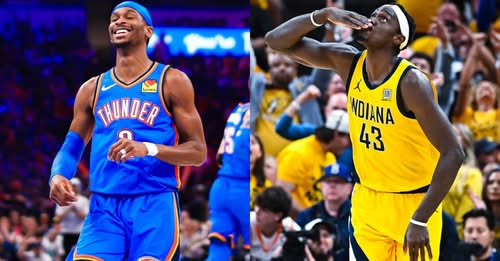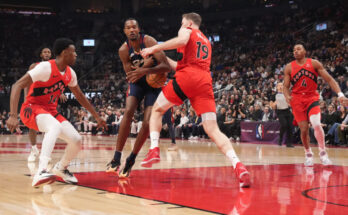The arena hummed with electricity, not the kind that came from lights or scoreboards, but the kind born of memory, vengeance, and the weight of unfinished business. It was opening week of the 2025–26 NBA season, and somehow, the league had orchestrated the perfect story: a rematch of the 2025 NBA Finals, this time in the regular season, with the defending champion Oklahoma City Thunder led by MVP Shai Gilgeous-Alexander facing off against the Indiana Pacers and Pascal Siakam in Gainbridge Fieldhouse.
This was not just another game. For Indiana, it was a reminder of how close they had come—just one win away, a few better possessions from holding the Larry O’Brien Trophy. For Oklahoma City, it was a chance to reassert their dominance, to silence any whispers that their championship run had been the result of favorable matchups or luck. There was no trophy on the line this time, but the emotions were just as real. The ghosts of June still lingered in the building.
Shai Gilgeous-Alexander stepped onto the court with the calm intensity that had defined his rise. He had carried the Thunder through the postseason with a level of composure and efficiency that had earned him the league’s MVP. His control of pace, his mastery of the midrange, and his unshakable demeanor had become the blueprint for modern leadership. Across from him, Pascal Siakam burned with a different kind of fire. A two-time All-Star and former champion himself, Siakam had come to Indiana to elevate this franchise. And he nearly had. The Finals loss had wounded him deeply, but it had also sharpened his resolve.
The crowd roared at tipoff, fully aware of the significance of this early-season matchup. Thunder in blue, Pacers in gold. The same colors, the same court, the same stakes—at least spiritually. From the opening possession, the pace was urgent. Oklahoma City ran crisp sets, with Jalen Williams curling off screens and Chet Holmgren stretching the floor, while Siakam took on the responsibility of creating early offense for Indiana, bullying his way into the paint and hitting tough fadeaways from the elbow.
But it was Shai who controlled the tempo. Every time Indiana made a run, he responded with the same surgical precision that had defined his Finals performances. A hesitation dribble here, a pull-up jumper there, a probing drive that collapsed the defense before he kicked it out to a shooter in rhythm. He was in command. Oklahoma City played with a fluidity that Indiana could not match, especially without their floor general Tyrese Haliburton, who was sidelined for the season after the devastating Achilles tear he suffered in Game 7 of the Finals.
That injury hung over this rematch like a shadow. The Pacers had spent the offseason retooling, but no one could replace Haliburton’s vision and pacing. He watched from the bench in a tailored suit, stoic, supportive, but visibly frustrated. The game moved on without him, but Indiana felt his absence with every possession that ended in a forced shot or a turnover.
The Thunder took advantage. Holmgren’s length altered shots inside. Caruso, added in free agency, was a defensive menace, hounding Pacers guards and creating transition opportunities. Josh Giddey, now coming off the bench, ran the second unit with poise. Oklahoma City’s depth was too much to contain. Still, the Pacers hung in. Siakam, refusing to let the game get away, strung together a series of midrange jumpers. T.J. McConnell injected energy with his relentless ball pressure. Bennedict Mathurin had his moments, slashing to the rim and drawing fouls, keeping the game within striking distance.
The first quarter ended with Oklahoma City up by eight. It felt like déjà vu. The Thunder had jumped out to leads in nearly every game of the Finals, dictating pace early and forcing Indiana to play catch-up. And yet, the Pacers always found a way to claw back. That pattern repeated itself tonight.
The second quarter opened with Indiana making defensive adjustments. They switched more aggressively, denying driving lanes, and crowding Gilgeous-Alexander on pick-and-rolls. The strategy worked for a stretch. The Pacers strung together stops and capitalized on the other end. Obi Toppin, now starting in place of the departed Myles Turner, ran the floor hard and finished in transition. Siakam hit a three from the top of the key, and suddenly the lead was down to three.
But just as quickly, Oklahoma City adjusted. Shai began using misdirection, slipping through double teams with spin moves and head fakes. On one possession, he split a trap, got into the lane, and dished a behind-the-back pass to a cutting Jalen Williams for a layup that silenced the crowd. Moments later, he took a defender off the dribble, pulled up from 17 feet, and hit nothing but net. That kind of shot—smooth, deliberate, unhurried—was his signature. Indiana could contest it, but they couldn’t stop it.
Halftime arrived with the Thunder up by six. The energy in the arena had ebbed slightly, replaced by a tense anticipation. The fans knew their team was undermanned, but they also remembered the fight these Pacers had shown last June. No one was leaving their seat yet.
The third quarter began with fireworks. Indiana came out swinging—McConnell hit a jumper, Siakam forced a turnover and finished with a dunk, and Mathurin knocked down a corner three to tie the game. The building erupted. For the first time all night, the Thunder looked rattled. Mark Daigneault called timeout.
Whatever was said in that huddle worked. The Thunder returned to the court with renewed focus. Holmgren blocked a shot on one end, then hit a trailing three on the other. Giddey pushed the tempo. Williams scored on back-to-back possessions, first on a catch-and-shoot three, then on a baseline drive. Then Shai took over. He isolated against Siakam, used a subtle step-through to create space, and dropped in a floater. Next trip down, he faked a pull-up, got the defender off balance, and lobbed it to Holmgren for an alley-oop. The Thunder were back in control.
By the end of the third quarter, the lead was 11. Indiana had spent so much energy catching up, they had little left to stop the onslaught. And when the Thunder got rolling, they were as balanced and dangerous as any team in the league. Their transition game, led by SGA and Giddey, was elite. Their half-court offense was diverse. Their defense, anchored by Holmgren and fueled by Dort and Caruso, was stifling.
The fourth quarter was more of the same. The Pacers fought valiantly—Siakam played nearly the entire frame, refusing to let his team quit—but the result felt inevitable. Shai put the game away with a flurry: a step-back jumper from the right wing, a tough finish through contact in transition, and a dagger three with just under two minutes left that pushed the lead to 14. He didn’t celebrate. He didn’t need to. His performance spoke volumes.
The final buzzer sounded, and the Thunder walked off with a 116–102 win. It wasn’t a blowout, but it wasn’t close either. It was decisive. Oklahoma City had picked up where they left off—sharp, connected, relentless. Indiana, meanwhile, showed grit but lacked the firepower. Without Haliburton and with new faces still learning their roles, the Pacers had heart but not enough weapons.
In the postgame interviews, Shai was humble, as always. He credited his teammates, praised Indiana’s effort, and spoke about setting the tone early in the season. Siakam, visibly frustrated, talked about execution, about needing more from the bench, and about using this loss as motivation. The loss stung, but he saw the long road ahead.
For fans watching around the country, this was more than a game—it was a chapter in an ongoing saga. The Thunder, behind their MVP leader, had defended their crown with poise. The Pacers, undermanned but unbowed, had shown they weren’t going away quietly. And somewhere down the road, these two teams may meet again on a bigger stage.
Until then, Shai Gilgeous-Alexander reminded the league why he was MVP. The Thunder reminded the world why they’re champions. And the Pacers? They reminded everyone they still believe they belong in that conversation.



